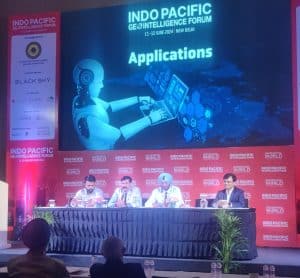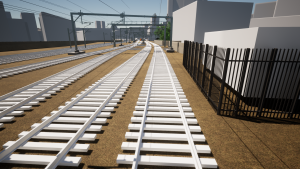The construction industry is not just one of the oldest industries; it’s also one of the least digitized industries. Human societies could not have achieved amazing things without the architecture, engineering, and construction Industry (AEC), yet many practices in constructing infrastructure have not changed for centuries. By nature and default, AEC is risk-averse, which is an attitude that also applies to technological adoption.
In the last decade, geospatial technology has helped to illuminate how technology can transform infrastructure projects. The onset of the pandemic accelerated the need for these ideas to become practiced in reality. Physical projects either had to halt or make a leap of faith into digital transformation.
The AEC industry is still in the early stages of AI adoption, taking steps towards the widespread digital literacy necessary for progress. However, the mindset change is happening now, and key players are taking this transition seriously. What was once a fringe idea will become a core value for future infrastructure projects.
Tech, construction and the demands of progress
The AEC industry is a conglomerate of many different disciplines that are presently being transformed by various technologies, and we are on the cusp of this exciting evolution. From a managerial level to physical work, tech can be implemented to improve visibility, communication, efficiency, and productivity, but it all begins with data.
In the 1980s, the collaboration between data scientists and geographers began, bringing two seemingly unrelated fields together that revolutionized how we map, measure and understand physical environments. Now marriages between different disciplines and technical fields continuously expand possibilities. New technologies provide a scope of implementation that is entirely open to how people can envision their future applications.
One of the most significant shifts in the construction industry is the adoption of algorithms and automation. Previously, stakeholders would estimate a project budget manually assisted by experience, but computers can more effectively synthesize vast amounts of data from various sources. Today’s algorithms are also trawling past projects to find patterns of past successes and failures, so we can learn more about what works and what doesn’t. This is just the beginning of how digital data and automation can assist infrastructure.
In terms of geospatial techniques, satellite technology revolutionized earth observation, but the data was expensive and slow to acquire. Modern day drone technology can provide information faster, on demand, more accurately, and at a lower cost. For construction, the data collected by drones can assist in turning a complex physical site into a highly detailed digital version. Digital Twin technology provides a regularly updated virtual 3D replica of any physical infrastructure that every stakeholder can use for monitoring and better decision-making. This is a significant development towards breaking down the silos that impact communication and, in many ways, mitigate the risks caused by physical site visits.
Construction is a dangerous profession. However, automation technology has the potential to remove much of this risk and speed up processes. 3D printing can be utilized in construction techniques that are time-consuming and limited by human physicality. In the future, autonomous vehicles and robots could safely carry out more and more onsite work. AI Automation is improving management and design, analyzing data that would take much longer to review and apply by humans alone.
Evolving infrastructure to meet societal needs
Several pressures are placed on infrastructure to meet the needs of a swiftly evolving society. Technological advancement has created a landscape where people are accustomed to having resources and information delivered swiftly and efficiently. This creates added pressure on the existing assets. Smart technologies can be implemented into infrastructure in a number of ways, but retrofitting older infrastructure is more challenging.
Adverse events such as the pandemic cause a spike in the evolution of human needs and behavior. As a result, the design and adaptation of infrastructure must catch up. Sudden changes such as millions working from home or a greater focus on virus prevention have changed how people interact with their environments. In terms of infrastructure, private and public buildings, transport, telecoms, and energy are likely to be impacted.
Technology can facilitate a pivot such as this by swiftly accumulating data and intelligence on the changed factors so decision-makers have the tools to assess how to respond efficiently and effectively. A city is like a living organism with its different systems and energy flowing through it daily, acting like its heartbeat. Data is vital to diagnose and facilitate changes within this ever-evolving organism.
Designing cities of the future
To fully understand human needs, we require technology. In the future, we need that technology to feed the information in real-time. If cities are like organisms, then the smart tech incorporated into infrastructure would represent an MRI scan or a life-support system showing constant and accurate information about how the city is functioning. With that technology in place, we can make better decisions regarding our infrastructure design and how urban processes interact with each other.
There has been a growing focus on new infrastructure builds and updates achieving sustainability targets such as energy efficiency or carbon neutrality. In the future, this will develop towards regeneration goals, so the infrastructure’s environmental footprint benefits the environment instead of just lowering the impact. New technologies for energy generation, water collection and filtration, and living walls will be vital for self-sustaining buildings, automation for maintaining these systems, and data collection.
Ultimately, these ideas require us to become more integrated as an industry. Humans work best when we collaborate. The geospatial and AI platforms currently used are working independently per specific project. But if these platforms could be combined, connected, and available to all, they could assist national and global infrastructure on a monumental scale. A digital twin of an entire city providing real-time visibility and data on every building and system would significantly help to improve functions, resolve problems, and design decisions.
There is still some fear surrounding the artificial intelligence utilized in the new technologies slowly transforming AEC and other industries. But to actualize the technology-integrated future utopias we envision, we will need to place trust in AI and identify the true social values behind its use.









